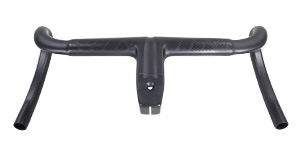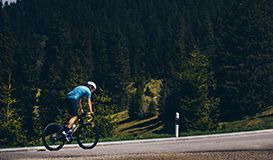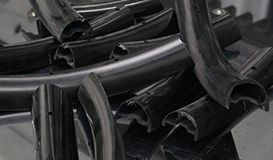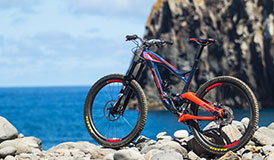Impact Test
The impact resistance test shows the overall structural performance of the wheels. Our impact test is performed on wheels without tires mounted. Eliminating the tire as a variable gives us cleaner results and helps to mimic bottoming out the rim on trail obstacles. With repeat strikes on test models, we’ll see how much impact force the bare wheels can endure.
Testing Goal
The aim of this test is to predict the behavior of bicycle wheels under normal and also extreme impacts. We need to make sure that the wheel remains unaffected by regular impacts that could occur during normal riding conditions. We gradually raise the striker height to increase the force, and hit the rim repeatedly until it eventually breaks. These are called destructive tests as they are designed to get more and more extreme until a failure occurs.
Test Standard
(1) Must get a pass result. Simulates an impact during normal riding conditions.
(2) At 87 Joules, no wheel crack nor lateral/radial run-outs over 0.5mm.
(3) Increase the strike force beyond 87 Joules.
(4) Discover the energy level that cracks the WR50 wheel.
Wheel Sample Profile
| Size | Model | Width | Depth | Rim Weight | Spokes | Spoke Tension | Wheel Condition |
|---|---|---|---|---|---|---|---|
| 700C | WR50 | 32mm | 50mm | 472g | Sapim CX Ray | 1177-1275N | Well trued & stress relieved |
Test Facility
Our impact test machine consists of a metric scale on the inner side of one pole to measure the drop height, a striker that can automatically move up and down, and a rigid base to hold the wheel firmly. Between the front two poles is a spring to keep the test point right under the striker.
Test Conditions
| Test Method | Vertical drop |
|---|---|
| Wheel State | Without tires |
| Energy Level |
Starting level: 62 joules Usability level: 87 joules (5J increment per round) |
| Test Positions |
Divide the rim by four: #1 Point: Valve hole #2 & #4 Points: Perpendicular to the valve (on either side) #3 Point: 180° away from the valve |
| Impact Striker | Flat steel anvil with a silicone rubber impact surface (Shore A hardness of 85+/-5 HA) Weight: 24kg |
| Base height (striker) | 42.2cm |

Methodology
- Step 1:Clamp the WR50 wheel on the rig, and slowly move down the striker until it rests on the #1 hit point. Record the striker’s base height (42.2cm).
- Step 2:Raise the striker to 68.56cm (with an effective height of 26.36cm) and drop it to hit the wheel.
- Step 3:Uplift the striker, inspect the wheel, and repeat the process for the other three test positions.
- Step 4:When the first round of impacts ends, start a new round with 5-Joule increments and hit the other test points in sequence. Repeat this process until the wheel cracks.

Specifications
We test with two purposes: to ensure that the wheel remains unaffected at a regular strike (the energy level we set is much higher than the UCI standard); and to explore the impact endurance of the WR50 wheel. These three criteria must be fulfilled during the impact test.
1. The rims must have passed the basic tests of trueness and stiffness before wheel building. The wheels must be well tensioned without any twist in the spokes and stress relieved before testing.
2. After the impact of 87J (usability level for WR50), there should be no rim crack, and the lateral/radial run-outs must be within 0.5mm. The wheel should be safe to hit the road.
3. When the crack on the rim is too minimal to affect the real riding, we would continue the test until a bigger crack occurs and see the energy difference between the two cracks. But the force we record as the maximum impact force for the test sample is the force that causes the first crack (minimal or obvious).
Test Results
| Raised Height (cm) | Height Increment (cm) | Energy (J) | Hitting Points | |||
|---|---|---|---|---|---|---|
| #1 | #2 | #3 | #4 | |||
| 68.56 | 26.36 | 62.0 | √ | √ | √ | √ |
| 70.69 | 28.49 | 67.0 | √ | √ | √ | √ |
| 72.81 | 30.61 | 72.0 | √ | √ | √ | √ |
| 74.94 | 32.74 | 77.0 | √ | √ | √ | √ |
| 77.06 | 34.86 | 82.0 | √ | √ | √ | √ |
| 79.19 | 36.99 | 87.0 (usability level) | √ | √ | √ | √ |
| 81.32 | 39.12 | 92.0 | √ | √ | √ | √ |
| 83.44 | 41.24 | 97.0 | √ | √ | √ | √ |
| 85.14 | 42.94 | 101.0 | √ | √ | √ | × |
The results are only valid for the tested sample.
Conclusions
After the 87J impact, the WR50 wheel looks unaffected (no rim crack; lateral/radial run-outs within 0.5mm). When the impact force reaches 101J, an obvious rim crack occurs at the #4 hit point. The ultra impact force that this WR50 wheel (without tire) can endure is about 101J.
© All photos and test data by Light Bicycle
Get in touch
Feel free to leave a comment if you have any questions or suggestions on our products or other issues.

Please leave your name here.
E-mail is required for further contact.
Please enter a message.
We use cookies for a better experience. Learn more.
Your Cookie Preferences
We use cookies to improve your experience on this website. You may choose which types of cookies to allow and change your preferences at any time. Disabling cookies may impact your experience on this website. You can learn more by viewing our Cookie Policy.
-
Cookies required to enable basic website functionality.
-
Cookies used to understand how the website is being used.
-
Cookies that are used to enhance the functionality of the website.
-
Cookies used to deliver advertising that is more relevant to your interests.
Aceept All Cookies
Save Preferences
Reject All Cookies
Save Preferences
Reject All Cookies
Accept All Cookies


















